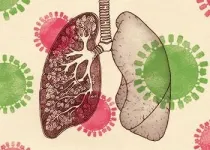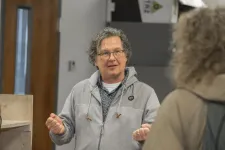Big data are no substitute for personal input in surveys
2021-07-02
(Press-News.org) When the analysis of digital data reaches its limits, methods that focus on observations made by individuals can be useful. In contexts such as the coronavirus pandemic, a method called human social sensing can elicit information that is difficult to obtain from digital trace data. Prof. Frauke Kreuter at Ludwig-Maximilians-Universitaet (LMU) in Munich is now using this method with the global "Covid Trends & Impact Survey" to predict the course of the pandemic.
Despite today's researchers in the social sciences having access to historically unparalleled amounts of data, many aspects of contemporary social developments have proven difficult to predict. National elections and the ongoing coronavirus pandemic are highly visible examples where current systems have been challenged to provide accurate forecasts.
"We shouldn't focus too narrowly on the analysis of digital trace data. It's a mistake to ignore the fact that people are equipped with sensory capacities. Those can be particularly useful in areas that are difficult to capture with data from behavioral traces", says Frauke Kreuter, Professor of Statistics and Data Science in the Social Sciences and the Humanities at LMU. Many social phenomena develop very rapidly - and often in unexpected directions. This makes it impossible to collect enough up-to-date passive data to enable researchers to trace the trajectories of such trends.
The individual as a human sensor plays a central role
In a research paper that has just appeared in the journal Nature, Kreuter and her international co-authors demonstrate that interviews with individual informants still have a crucial role to play, even in an era where big data generates the biggest headlines. "One should never lose sight of the fact that surveys can serve as a very valuable source of supplementary information", she says.
An individual interviewee is in a position to supply information not only about her own situation, but also, "individual interviews allow one to ask individuals about themselves and also about things in their local environment. However, the latter possibility has long been overlooked." And now, in this current context, it is beneficial to make use of the fact that the individual can be viewed as a potentially informative 'social sensor' for what is happening around him.
The development of the coronavirus pandemic as a test case
As a statistician, Frauke Kreuter chose to employ together with her colleagues this approach in the current global "Covid Trends & Impact Survey", which attempts to forecast the trajectory of the coronovirus pandemic. The survey began in April 2020, and over 55 million people globally have been interviewed. One of the queries asks interviewees whether they personally know anyone in their local community with COVID-19 symptoms.
This is of particular salience as, "the answers to this question turn out to be a strong predictor of the further development of the pandemic", says Kreuter. Preliminary results of the study have already appeared as a preprint on MedRxiv. "The crucial prerequisite for the use of individuals as sensors in social-science surveys is that the informants chosen must constitute a controlled and representative sample of the population of interest."
INFORMATION:
ELSE PRESS RELEASES FROM THIS DATE:
2021-07-02
The seasonal flu kills up to 600 000 people a year worldwide and has a century-long history of pandemics. Examples include the Spanish flu in the late 1910's or the H1N1 in 2009, which together claimed more than 50 million lives. "The way the stage is set tells us that it is not a matter of if but rather of when there will be a next pandemic. And preparing ourselves for that demands intensive fundamental research and constant accumulation of knowledge about these viruses and the diseases they cause", says Maria João Amorim, IGC principal investigator and leader of the team that conducted the study.
When a virus like influenza enters our lungs, it is quickly faced with cocktails of ...
2021-07-02
An international study has elucidated the structure of a protein that is required for the assembly and stability of photosynthetic membranes.
Plants, algae and cyanobacteria convert carbon dioxide and water into biomass and oxygen with the aid of photosynthesis. This process forms the basis of most forms of life on Earth. Global warming is exposing photosynthetic organisms to increasing levels of stress. This reduces growth rates, and in the longer term presents a threat to food supplies for human populations. An international project, in which Ludwig-Maximilians-Universitaet ...
2021-07-02
Researchers based in Munich and Tuebingen have developed an open-source camera system that images natural habitats as they appear to rodents.
During the course of evolution, animals have adapted to the particular demands of their local environments in ways that increased their chances of survival and reproduction. This is also true of diverse aspects of the sensory systems that enable species to perceive their surroundings. In the case of the visual system, these adaptations have shaped features such as the positioning of the eyes and the relative acuity of different regions of the retina.
However, our knowledge of the functional evolution of visual systems in mammals has remained relatively sparse. "In the past 10 or 15 years, the mouse has become the favored model ...
2021-07-02
Elisa Cordero, a doctor at the Virgen del Rocío University Hospital, researcher at the Institute of Biomedicine of Seville (IBiS) and professor in the Department of Medicine at the University of Seville, led a study involving researchers from 12 Spanish hospitals to study the clinical characteristics and facilitate the prognosis of solid organ transplant recipients with COVID-19.
The study provides a more precise description of the complications caused by Covid-19 in organ transplant recipients and has provided useful clinical indicators to identify the disease early. This makes it possible to determine therapeutic and care measures ...
2021-07-02
There are plenty of negatives associated with smart technology -- tech neck, texting and driving, blue light rays -- but there is also a positive: the digital age is not making us stupid, says University of Cincinnati social/behavioral expert Anthony Chemero.
"Despite the headlines, there is no scientific evidence that shows that smartphones and digital technology harm our biological cognitive abilities," says the UC professor of philosophy and psychology who recently co-authored a paper stating such in Nature Human Behaviour.
In the paper, Chemero and colleagues at the University of Toronto's Rotman School of ...
2021-07-02
A new study disputes the prevailing hypothesis on why Mercury has a big core relative to its mantle (the layer between a planet's core and crust). For decades, scientists argued that hit-and-run collisions with other bodies during the formation of our solar system blew away much of Mercury's rocky mantle and left the big, dense, metal core inside. But new research reveals that collisions are not to blame--the sun's magnetism is.
William McDonough, a professor of geology at the University of Maryland, and Takashi Yoshizaki from Tohoku University developed a model showing ...
2021-07-02
Ibaraki, Japan - The flavor of a tomato is an interaction between its taste and aroma. Now, researchers from Japan and the United States have revealed that the pigments that determine the colors of tomatoes also affect their flavor.
In a study published this month, researchers from University of Tsukuba developed a new method to rapidly measure the pigment profiles of tomatoes and used the technique to explore how pigments affect the taste and aroma of different tomato varieties.
The color of tomatoes is produced by combinations of different types of pigments, including carotenoids and chlorophylls. These pigments can also affect the accumulation of flavor-related compounds such as sugars, which affect the taste of tomatoes, and volatile ...
2021-07-02
A surprising study by UNSW on the behaviour of unrelated lizards in very different parts of the world has demonstrated how evolution can lead to different species learning the same skills.
The study in Ecology Letters documents how the Anolis lizard species in the Caribbean, and the Draco lizard species in Southeast Asia, have solved the challenge of communicating with one another to defend territories and attract mates.
It found males from both species perform elaborate head bob and push up displays, and rapidly extend and retract their often large and conspicuously coloured dewlap, or ...
2021-07-02
The muskrat, a stocky brown rodent the size of a Chihuahua - with a tail like a mouse, teeth like a beaver and an exceptional ability to bounce back from rapid die-offs - has lived for thousands of years in one of Earth's largest freshwater deltas, in northeastern Alberta, Canada.
Today, this delta lies within one of the largest swaths of protected land in North America: a national park five times the size of Yellowstone that's home to the planet's biggest herd of free-roaming bison and the last natural nesting ground for the endangered whooping crane. It's also central to the culture ...
2021-07-02
Guadalupe fur seals (Arctocephalus townsendi) have established a large resting colony in the Gulf of California--bringing the total number of sites where this endangered species now occurs to just four. This new haul-out was discovered on El Farallón de San Ignacio Island, along the mainland coast of Mexico, according to researchers from Mexico and the University of British Columbia.
Guadalupe fur seals were hunted for their furs and declared extinct in the late 1800's. However, 14 individuals were discovered on Guadalupe Island in 1950--and the population has grown since then. While still designated as vulnerable to extinction, according to IUCN, the population is believed to total 41,000 individuals and is growing ...
LAST 30 PRESS RELEASES:
[Press-News.org] Big data are no substitute for personal input in surveys



